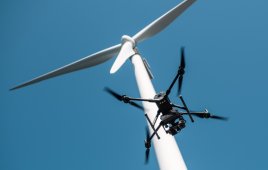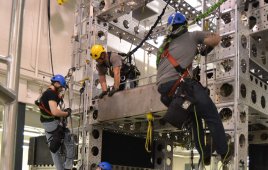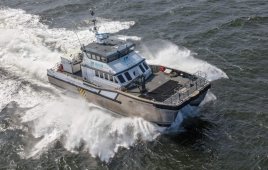You might think Mother Nature does not much like wind turbines and their maintenance crews. Consider that strong winds, essential to power production, present a danger to those working at height. Ice is hazardous on blades because it adds weight that strains them and it ruins a turbine’s power output. Lightning, however, is the biggest weather threat to wind turbine O&M crews. Turbines are usually the tallest structures in the area, so they are prone to strikes.

“Warning. Lightning due west and headed your way.” Uptower O&M crews working on a wind farm in Virginia can receive messages of this sort from MxVision WeatherSentry when hazardous weather approaches a monitored area.
“Our main weather concern is lightning,” says Suzlon monitoring center manager Richard Duesing. The company monitors some 2,500 of its turbines around the U.S. “We don’t want anyone in a tower when we see lightning approaching the area.”
To help manage their weather challenges, companies such as Suzlon rely on advanced weather warnings with tools such as the MxVision WeatherSentry, Online Wind Energy Edition. The package, from developer Schneider Electric (www.schneider-electric.com/us) includes a site license for each wind farm and a national license for the OEM. Suzlon gives its supply chain and service teams access to the system.
“We subscribe to a national lightning-detection network for help with location and intensity of lightning strikes,” says Don Leick, Senior Energy Product Manager with Schneider Electric.
Suzlon prefers several alerts levels. “For instance, at 60 miles, we let our crews know inclement weather is coming so they can finish what they are working on. At 30 miles, the site must be completely evacuated and crews moved to safety,” says Duesing.
Leick adds that delivering information by internet helps wind industry workers navigate changing weather that can endanger employees and impact operations. A mobile version of the service provides crews with on-the-go access to critical

WeatherSentry also provides wind speeds (black plot) and gusts (green). Light blue shading shows actual data. Pink shading is forecasted.
weather information. “Forecasters prepare hourly and daily predictions for precipitation and lightning strikes. These along with radar sweeps are delivered by cell phone or email right to the tech. There is no middle man,” says Leick. The notification system sends customizable weather alerts 24/7 to any email-compatible device, so service crews can focus on other tasks. The arrangement lets O&M crews ask forecast specific weather questions and get answers. Warnings can be audible to tell of changes in wind speed, watches, and advisories from the National Weather Service.

More than 60 wind farms across the U.S. rely on some 1,250 Suzlon turbines to generate about 2,500 MW. To help keep company maintenance technicians safe from severe weather, a team of 12 people in the Suzlon Monitoring Center keep an eye on conditions around the clock.
The Suzlon monitoring center, for instance, watches for high-wind alerts. “We don’t let our crews go up-tower when the wind exceeds 25 m/sec,” Duesing explained. Wind limits the type of work done in the turbines — they do not schedule work in the hub when speeds exceed 15 m/sec.
In addition, technicians receive all-clear alerts by cell phone when it’s safe to return to the field. “We let crews return to the towers once we’ve verified there are no lingering strikes within 60 miles of the site for at least 30 minutes,” he said.
“The forecasts help us be more proactive when scheduling maintenance, letting us work smarter,” said Duesing. “For example, if we see that high winds are expected in an area where we were planning on crane work, we will delay bringing in the crane for a day or two, until the winds are expected to subside. It doesn’t make sense to pay for a crane on site if it’s not doing anything.”
Leick tells how operator thinking has changed thanks to better forecasts. “Not long ago, their focus was on uptime. Then they got smarter with better forecasts and focused more on production. But power prices vary so the operators have taken another step and work to maximize revenues, which mean they may take turbines out of service when prices or wind is low. That’s the value of an accurate seven-day forecast.” WPE
Filed Under: Featured, Safety




